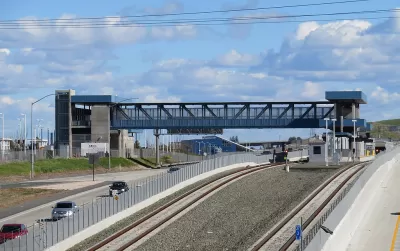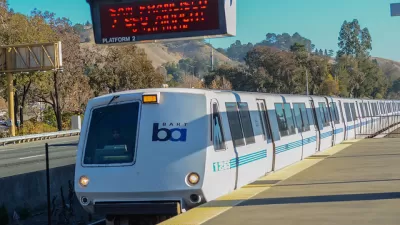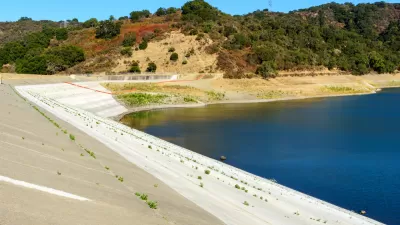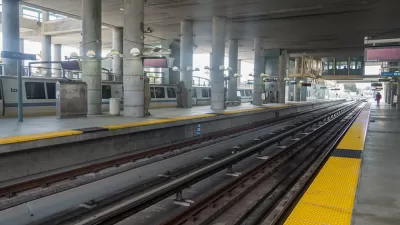By building a diesel-powered train line for the 9.2-mile extension to Antioch in East Contra Costa County, BART saved almost $500 million and began service earlier than had it extended the existing line, though a transfer is required between trains.

Unlike traditional diesel-powered, locomotive-hauled commuter trains, the new Bay Area Rapid Transit (BART) trains traveling to Antioch in East Contra Costa County from the Pittsburg/Bay Point station will be quiet, self-propelled diesel multiple unit (DMU) trains burning renewable diesel, a biofuel also powering some locomotives on Amtrak's Capitol Corridor line from San Jose to Sacramento, rather than fossil diesel fuel. Conventional BART trains are electric-powered using third rail propulsion.
Until May 26, when revenue service began to the extension's two new stations, Pittsburg Center and Antioch, the 55-mile BART line had been called Pittsburg/Bay Point–SFO/Millbrae. [Wikipedia hadn't changed the name as of May 25, though it describes the extension here.] The extension was referred to as "eBART" during the project phase, a name that may stick even after service begins.

Courtesy of BART
"The new eBART trains can fit 104 people sitting down and 96 standing and will be able to transport 2,400 people per hour from Antioch to the transfer platform at Pittsburg/Bay Point BART station in around 10 minutes," writes Aaron Davis, who reports on East Contra Costa County for the East Bay Times. "Trains coming from the Pittsburg Center station at Railroad Avenue will take three minutes to arrive at the transfer platform."
Not like the BART/Caltrain transfer at Millbrae station
At Millbrae, the southwest terminal station of the 65-mile Antioch line in San Mateo County, passengers can transfer between BART and Caltrain, a traditional diesel-powered commuter train. The transfer can be awkward and time-consuming as BART stations are enclosed by barriers like traditional heavy rail systems. While the fare media is identical for customers using Clipper Cards, one must still "tag-off" one train system and "tag-on" to board the other. Worse yet, transfers aren't timed and can involve two escalator/elevator/stair climbs and require running through a concourse to get to the appropriate platform.
At the Pittsburg/Bay Point transfer station, the cross-platform transfer requires a mere 10 steps with no fare changes, i.e., it's the same as transferring between BART lines at other stations. Unlike Millbrae, transfers will be timed, with 0-2 minute waits in the peak direction, and 8-minutes for reverse commuters (see FAQ).
Michael Cabanatuan, a transportation reporter for the San Francisco Chronicle, writes, "The extension cost $525 million, compared with an estimated $1 billion it would have cost to build a conventional BART line 10 miles from Pittsburg to Antioch."
It might be better than no line at all, but there’s still grumbling in eastern Contra Costa about having to transfer from one train to another rather than being able to ride station to station on standard BART trains.
Transit-oriented development?
The extension appears to be designed for auto-commuters, running at 75 miles-per-hour in the median of a freeway, State Route 4. The terminal station, Antioch, boasts over 1000 parking stalls, with over a third "shaded by solar panels." Pittsburg Central has 240 stalls. The FAQ refers readers to Tri Delta Transit for more information.
FULL STORY: eBART extension to central Pittsburg and Antioch opening Memorial Day weekend

Planetizen Federal Action Tracker
A weekly monitor of how Trump’s orders and actions are impacting planners and planning in America.

Maui's Vacation Rental Debate Turns Ugly
Verbal attacks, misinformation campaigns and fistfights plague a high-stakes debate to convert thousands of vacation rentals into long-term housing.

San Francisco Suspends Traffic Calming Amidst Record Deaths
Citing “a challenging fiscal landscape,” the city will cease the program on the heels of 42 traffic deaths, including 24 pedestrians.

Amtrak Rolls Out New Orleans to Alabama “Mardi Gras” Train
The new service will operate morning and evening departures between Mobile and New Orleans.

The Subversive Car-Free Guide to Trump's Great American Road Trip
Car-free ways to access Chicagoland’s best tourist attractions.

San Antonio and Austin are Fusing Into one Massive Megaregion
The region spanning the two central Texas cities is growing fast, posing challenges for local infrastructure and water supplies.
Urban Design for Planners 1: Software Tools
This six-course series explores essential urban design concepts using open source software and equips planners with the tools they need to participate fully in the urban design process.
Planning for Universal Design
Learn the tools for implementing Universal Design in planning regulations.
Heyer Gruel & Associates PA
JM Goldson LLC
Custer County Colorado
City of Camden Redevelopment Agency
City of Astoria
Transportation Research & Education Center (TREC) at Portland State University
Jefferson Parish Government
Camden Redevelopment Agency
City of Claremont





























